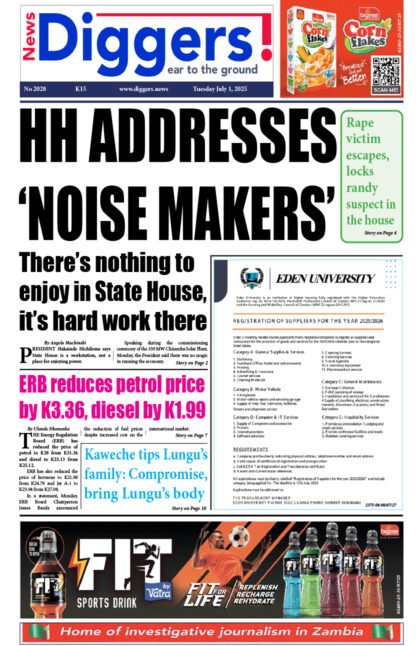The European Union (EU) has pumped in K650 million towards the implementation of the EU-COMESA Trade Facilitation Program whose aim is to enhance regional economic integration and establishment of a continental free trade area.
Speaking during the signing ceremony in Lusaka, Wednesday, EU Representative to COMESA Alessandro Mariani said the EU-COMESA Trade Facilitation Program would greatly contribute to the implementation of the New Africa-Europe Alliance for Sustainable Investment and creation of Jobs.
“I am pleased and honoured to participate in the signing ceremony and official launch of the COMESA Trade Facilitation Programme supported by the European Union and COMESA for a total amount of 48.3 million EURO (approximately 650 million of Zambian Kwacha). I would like to start by thanking the Secretary General of COMESA and her team for the excellent work and the great collaboration that they offered to the European Union during the formulation of this program. I would also like to thank colleagues from UNCTAD and FAO for their cooperation and their valuable contributions. The European Union, being COMESA’s biggest trade and development partner (including in the area of trade facilitation), attaches the highest importance to its long-lasting partnership with COMESA to promote regional economic integration. While the European Union recognises COMESA’s role as a driving force of regional economic integration, we are also very much aware of the importance of its Member States that are ultimately responsible for the domestication of the regional policies and programmes,” Ambassador Mariani said.
“This EU-COMESA Trade Facilitation Programme is of utmost importance and will greatly contribute to the implementation of the New Africa-Europe Alliance for Sustainable Investment and Jobs recently launched by the European Union and aimed at substantially boosting private investment in Africa, strengthening trade, and creating jobs. Support to regional economic integration is at the core of this Strategy, including the support of the negotiations of the African Continental Free Trade Area (CFTA) with the long-term perspective to create a comprehensive continent-to-continent partnership between the European Union and Africa. COMESA has certainly a fundamental role to play as one of the building blocks of the future continental architecture. COMESA region experiences low level of intra-regional trade, partly due to supply side constraints but also because of the high cost of trading. Poor infrastructure, restrictive practices, complex and restrictive rules of origin and transit traffic issues, proliferation of Non-Tariff Barriers and the impact of Sanitary and phytosanitary (SPS) and technical standards measures are some of the main challenges.”
He said COMESA would use the funds to assist member states to monitor Non-Tariff Barriers (NTBs) subsequently reducing the transportation costs of goods across the countries.
“The EU-COMESA Trade Facilitation Programme responds to these challenges and aims at increasing intra-regional trade flows of goods, persons and services in line with COMESA’s core mandate. This four-year programme includes activities that will be implemented at regional level as well as interventions targeting selected border posts in strategic regional transport corridors. The project will: First of all, provide COMESA the means to assist its member states in the monitoring and resolution of Non-Tariff Barriers (NTBs), leading to the reduction of transportation costs and increase of speed of delivery. It will contribute to improve the levels of implementation of harmonised Sanitary and Phyto-Sanitary (SPS) Measures and Technical Standards, so to ensure that consumers in the region can be supplied with safe food while -at the same time – preventing unjustified health and safety regulations from being used to improperly protect domestic producers. Through this project, support will also be provided to trade in services, free movement of persons and trade negotiations,” Ambassador Mariani said.
“The EU will continue to support the negotiations at Tripartite-level (with SADC and the EAC) as well as at continental level for a Continental Free Trade Area. This is the testimony of the EU strong engagement towards economic integration on the African continent and the recognition of COMESA’s key role as one of the building blocks of the future continental architecture. Under the 11th European Development Fund the European Union has opted for a much more focused approach, so to ensure that tangible results are achieved on the ground and citizens can concretely benefit from regional economic integration. Coordinated Border Management is one of those areas where we can together achieve these results. The customs environment in the COMESA region is still characterised by lack of coordination between the multiple government agencies and duplication of procedures at border posts.”
He revealed that five borders had so far been selected for upgrade in readiness for the implementation of the program.
“For this reason we have selected, in close consultation with COMESA and its Member States, some border posts for their upgrade with a view to establishing operational One Stop Border Post (OSBP) facilities and facilitate trade flows. Those border posts are Mwami/Mchinji (between Zambia and Malawi), Nakonde/Tunduma (between Zambia and Tanzania), Chirundu (between Zambia and Zimbabwe), Moyale (between Kenya and Ethiopia) and Galafi (between Djibouti and Ethiopia). COMESA Member States will be entrusted with the implementation of part of the activities at these selected border posts,” said Ambassador Mariani.


















